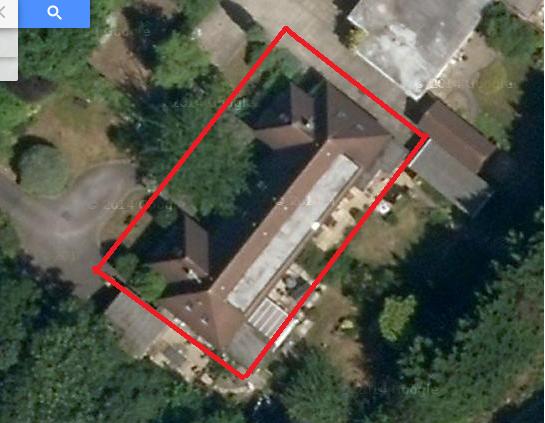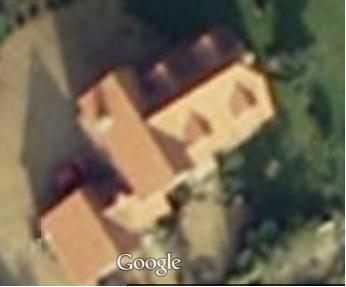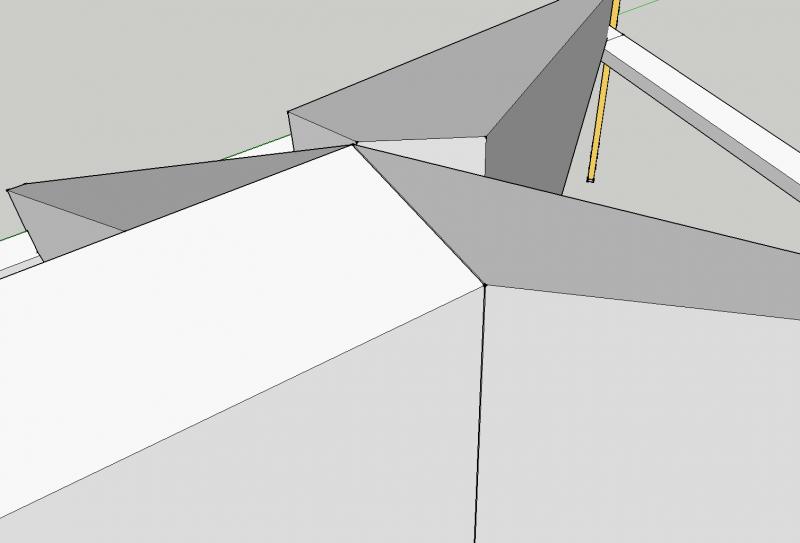You are using an out of date browser. It may not display this or other websites correctly.
You should upgrade or use an alternative browser.
You should upgrade or use an alternative browser.
Cut and pitching roofs
- Thread starter chamfer
- Start date
I can see why you described cut roofs as complex roofs now.
They can be, yes. But once you have done a few, they become less difficult.
A few - like fifty or so.
- Joined
- 11 Jan 2012
- Messages
- 109
- Reaction score
- 2
- Country

You now have the plane of the hip blade, albeit on the underside of the resting hip blade. You can now use the bevel and a short level to gauge the plumb cut and set it on the bevel.
I have adjusted the mitre on the plate so it shows 50mm on the corner face, am I still on the right track?
Also while reading up on the subject I saw saddleboards being used, what are they for and do I need half of one in this model?
I can see why you described cut roofs as complex roofs now.
They can be, yes. But once you have done a few, they become less difficult.
A few - like fifty or so.
I know what you mean.
Last one I cut in London with my brother 25 years ago. 2 three bed flats in that one. The dormer is 18m
One I cut on my own over steels in Norfolk about 20 years ago.
Also while reading up on the subject I saw saddleboards being used, what are they for and do I need half of one in this model?
You would only use saddleboards where much of the plumb/cheek cuts on Hip/valley rafters would be in free air.
Yep, this is how we get the plumb cut angle.
I have adjusted the mitre on the plate so it shows 50mm on the corner face, am I still on the right track?
You then remove the rafter (and the short pair of jacks) and do the top cut on the hip rafter.
This will be a pair of 45° end cuts, marked using the bevel. This is so that it fits centrally and snug in the crook of the commons.
You then offer it back into place and rest it so that it just touches the wall plate and is sitting high in the top cut. Use your short level on the bottom cut (just temporarily do a bottom plumb cut for levelling purposes), move the hip up or down to see just where the exact position is.
You then mark off your wall plate b/m and measure how much the top cut needs to drop to determine the thickness or depth of the b/m plumb cut.
Yes we fix an 18mm ply gusset to collect the top plumb cut, usually fixed as a triangle across the tops of the last two commons on a free ended hip.
However, your image is showing a kind of lean-to hip. You just need to fix something to the wall in order to collect all of the plumb cut.
However, your image is showing a kind of lean-to hip. You just need to fix something to the wall in order to collect all of the plumb cut.
You can also add a dragon tie to the wall plate to help prevent spread. We normally try and slot one of these in prior to fixing the smallest jacks.
Looking at the picture you can see my Hip rafter is too high, do you drop the hip rafter to suit the commons or do you bevel it on both edges?
The true plane of the hip rafter should be level with the commons etc. You need to drop the rafter so that its edges are in line with the roof plane i.e. the very peak of the hip will sit slightly lower.
You then follow the corner edges of the hip blade when measuring and fixing your jacks. It is this edge which gives you your accuracy. What you have to imagine is, that whilst opposing jacks will finish at the edge of the hip blade, if the hip weren't there the jacks would go on to meet at a point slightly higher than the edges of the hip blade.
In the olden days the hip blades would have been planed in an inverted 'v'.
However there is not much merit to this method as the roofing laths do not do an awful lot at this point. You will still be able to fix the lath ends without causing any bending etc.
Sorry, yes hip blade/hip rafter are the same things.When you say Hip blade is this another name for hip rafter?
Perfect.
I have to say, that your ability to follow what I am saying and translate this into (very good) drawings is a credit to your imagination.
Most people just scratch their heads and look confused when I'm blathering on.
Most people just scratch their heads and look confused when I'm blathering on.
- Joined
- 11 Jan 2012
- Messages
- 109
- Reaction score
- 2
- Country

I have to say, that your ability to follow what I am saying and translate this into (very good) drawings is a credit to your imagination.
Most people just scratch their heads and look confused when I'm blathering on.
Mr noseal your blathering has got me further than any book or video I have ever read on the subject, and believe you me I have read and watched quite a lot. I was just about to give up again on understanding cut and pitch before you replied so I am very great full
Normally I am looking at book scratching my head thinking what the hells does that mean.
DIYnot Local
Staff member
If you need to find a tradesperson to get your job done, please try our local search below, or if you are doing it yourself you can find suppliers local to you.
Select the supplier or trade you require, enter your location to begin your search.
Please select a service and enter a location to continue...
Are you a trade or supplier? You can create your listing free at DIYnot Local
Similar threads
- Replies
- 3
- Views
- 1K
- Replies
- 0
- Views
- 1K





